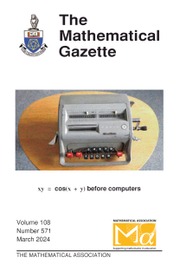No CrossRef data available.
Article contents
Some Applications of the Theory of Assemblages
Published online by Cambridge University Press: 03 November 2016
Extract
In order to be able to apply the theory of real numbers to measurable quantities, in particular to linear magnitudes, it is convenient to make use of the theory of groups (displacements). Thus, if B, C, D, …, Y are successive points on a continuous line between the extremities A and Z,
AB+BC+CD+…+YZ=AZ,
where AB, BC, … are arcs or consecutive displacements on the given line.
Information
- Type
- Research Article
- Information
- Copyright
- Copyright © Mathematical Association 1902
References
page 173 note * See in this connection,
Lagrange: Lectures on Elementary Mathematics, p. 3; translation by Th. J. Carnack.
Dedekind: Essays on the Theory of Numbers, pp. 1-27; translation by Prof. Beeman.
E. Borel, Leçons sur la Théorie des Fonctions, vol. i., p. 111.
page 173 note † Any other closed curve would do; the circle has been chosen on account of its simplicity.
page 174 note * See an interesting note of E. Maillet, Comptes Rendus, vol. cxxxiii., No. 20, pp. 782-784. “Sur les équations différentielles rationelles.”

